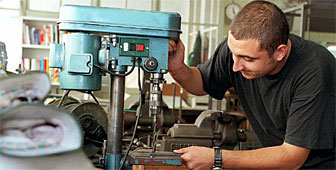Unemployment climbs toward symbolic level

Unemployment is creeping closer to the 100,000 mark in Switzerland, but the authorities are confident the jobless rate will drop in the near future.
Unemployment is hovering around the 2.6 per cent mark – low in comparison with most countries, but high enough to cause unease in Switzerland.
The trend is also disheartening – in the first two months of the year unemployment shot up with 8,458 people joining the ranks of the unemployed, taking the number of jobless to 94,472.
But the rise was far smaller in February, prompting the economics minister, Pascal Couchepin, to predict that the trend would slow in the coming months. “The number of jobless will not go above 100,000 and the unemployment rate should not reach three per cent,” he said.
Earlier, the State Secretariat for the Economy (Seco) backed up this analysis, saying the trend will be reversed by an upturn in the economic climate in the coming months.
Growth forecast
“The perspectives for the next few months are encouraging, and the unemployment rate should stabilise itself this spring before it starts to drop by the middle of this year,” said Alan Kocher of Seco. “Consumer confidence has remained good, and we have several indicators that show that economic growth will continue.”
The federal economy specialists point out the drop in the number of long-term unemployed people as another reason to be optimistic.
“The work market is very dynamic, and there are fewer people who have been out of a job for more than a year,” Kocher told swissinfo. “Just 11 per cent of the unemployed have been out of a job for more than 12 months, down from one in three during the worst period of the last few years.”
“Too optimistic”
Not everyone shares Seco’s cheery outlook though. “I feel they being a bit too optimistic,” said George Sheldon, a labour market specialist at Basel University.
“Layoffs have risen steeply in the last few months, and there are no obvious signs the economy will pick up in the near future,” he told swissinfo. “I expect unemployment to average 2.8 per cent this year.”
Although the jobless rate is high for Switzerland, compared with most its neighbours, unemployment remains quite low. Sheldon says the Swiss labour market benefits from advantages that other countries don’t have.
“The Swiss labour market is very flexible. Salaries, are for example, usually negotiated between management and unions for one company in Switzerland, versus whole industries in countries like Germany.”
“The last few years have also seen strong job growth, which has also helped keep Swiss unemployment figures low.”
Switzerland still exports some of its jobless according to Sheldon. “The job market is very open by European standards, with many foreigners working on short-term contracts or who leave if they lose their jobs,” he said.
The situation has improved compared to a few years ago though.
Foreigners’ impact
“In the past, up to 90 per cent of a downturn was absorbed by foreign workers,” Sheldon told swissinfo. “Part of the reason that unemployment figures are higher is that more foreigners have settled in Switzerland and stay here even if they lose their job.”
In the future, exporting unemployment will become even more difficult.
“This phenomena will mostly disappear with the introduction of the bilateral treaties between Switzerland and the European Union,” said Kocher. The agreement on free movement of people institutes certain guarantees for the unemployed.
Current unemployment rates are half of what they were in 1997. Part of the reason this figure dropped dramatically in the years that followed was the introduction of so-called active measures – special training courses to increase workers’ market value, make-work programmes or special subsidies.
Figuring the rate
Active measures concern in fact about one third of all job seekers, although they don’t show up in unemployment statistics. In a sense, these measures are a way of artificially lowering the number of jobless people according to Sheldon.
“By international standards, you don’t count people who are concerned by active measures. But if you take them into account, the unemployment rate would be above three per cent.”
The actual value of these active measures is also debatable. “If you look at the make-work programmes, most of the people who spend six to 12 months in them usually rejoin the ranks of the unemployed,” said Sheldon.
“Measures to re-qualify people have also proven not to be particularly effective.”
The researcher does not however just paint a black picture. “With special compensation subsidies, people have accepted to take on less-well paid jobs, getting them back into the workforce,” he told swissinfo.
by Scott Capper

In compliance with the JTI standards
More: SWI swissinfo.ch certified by the Journalism Trust Initiative
You can find an overview of ongoing debates with our journalists here. Please join us!
If you want to start a conversation about a topic raised in this article or want to report factual errors, email us at english@swissinfo.ch.